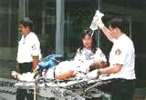
MMWR Paper Explains 2006 EMS Decision Scheme
A Morbidity and Mortality Weekly Report paper on the process and rationale used by experts who revised the American College of Surgeons' Field Triage Decision Scheme for publication in 2006 gives a thorough look at the decisions involved. First published in 1986, the scheme is an algorithm used by about 800,000 EMS personnel nationwide. It takes EMS providers through four decision steps (physiologic, anatomic, mechanism of injury, and special considerations) to determine the most appropriate destination within the local trauma care system. The paper was published in last Friday's MMWR.
Corresponding preparer Marlena Wald, MLS, MPH, of the Division of Injury Response in CDC's National Center for Injury Prevention and Control, and 12 co-authors have written an extensive paper because the 2006 revision, while containing multiple changes from the 1999 version, was published without an accompanying rationale, they write. This paper is intended to expand dissemination of the 2006 scheme and future schemes, and to explain the rationale behind new triage criteria in the 2006 version. (To contact Wald, phone 770-488-4230, fax 770-488-3551, or e-mail [email protected].)
Recommendations contained in this paper have been endorsed by numerous organizations, ranging from the Air Medical Physician Association to the American College of Emergency Physicians, the American College of Surgeons, the American Medical Association, the American Public Health Association, the International Association of Flight Paramedics, the Joint Commission, the National Association of Emergency Medical Technicians, and the National Association of EMS Physicians.
The paper says about 5 million deaths worldwide and millions of temporary or permanent disabilities result from injuries each year. And the global burden of injury is expected to increase substantially by 2020.
The authors say implementing and updating the protocols at the local level "will require a substantial educational and informative effort." CDC, with additional funding from NHTSA, is developing a toolkit to help state and local EMS personnel and public health officials understand why the Decision Scheme was revised and how the revisions can be tailored to the needs of their own communities. This toolkit will be available free from CDC.